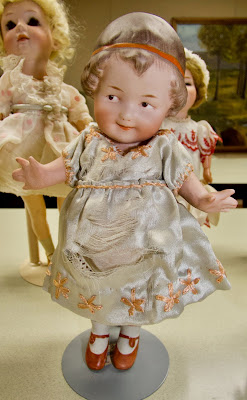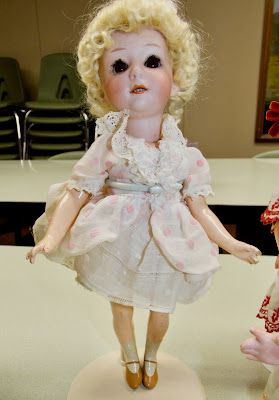The refreshment table was decked out in red and covered with sweet treats in honor of upcoming Valentine's Day.
Beautiful vintage Madame Alexander Cissy dolls from member Myrna Loesch, each offering a heart-shaped candy box, decorated the tables.
Member Sharon Weintraub did a program on Gebruder Heubach character dolls. She told the club that Brothers Christopher and Phillip Heubach purchased an established porcelain factory in1840 in Lichte, Thüringia, Germany (Gebruder means brothers). In 1882, the company registered its mark of a sunrise symbol with "GH" inside. The factory produced porcelain figurines and other decorative objects, with the first mention of the production of doll heads occurring in 1910. The factor produced bisque character heads and all-bisque dolls, often using sculptors from nearby art school. In 1910, the company registered another mark of Heubach in a square. The company declared bankruptcy in 1938.
Heubach supplied bisque doll heads to other factories, which helps explain why the heads are found on a wide variety of bodies and why some heads may be found with no marks. The bodies range from very cheap crude composition or cloth to higher quality kid and ball-jointed bodies. High production at the factory lead to worn molds, so mold numbers were blurred or lost. This causes confusion among modern collectors trying to authenticate a doll. However, Sharon said, even with missing mold numbers, there is no mistaking Heubach’s style. For its painted-eye characters, Heubach used intaglio eyes, in which the iris is indented, giving the eyes depth. The all-bisque dolls have starfish hands with the middle and ring fingers jointed.
These three Asian character dolls are called Chin-Chin. They are each 4.5 inches tall and faintly incised under their feet with the Heubach square mark. The girl has her original paper labels
This 7.75 inch tall Heubach smiling girl is called "Coquette." She has pillar legs.
This 8-inch tall version of Coquette has jointed legs. There are no visible marks.
Wearing her original ethnic costume, this 8.25-inch tall girl is incised on her back "9558" and "3."
Known among collectors as the "three-bow girl," this charming child is 9 inches tall and incised "10490//3" on the small of her back.
Heubach used precolored slip for some of its bisque heads, the slip already having a pink or skin tone. This 3.75-inch tall Coquette shoulderhead is made of a pale pink precolored bisque. The head is incised on the back with square Heubach mark and “1” over “Germany” and “7856.” There is also a small green artist’s mark; these green marks are often found on Heubach heads.
These two googly-eyed kitties each carry the Heubach square mark on the back of their necks. They are 6 inches tall, have composition bodies textured to look like fur, and wear their original outfits.
Heubach also made dolls with glass eyes. This 9-inch tall Gebruder Heubach 6971 character head is on a good quality composition and wood ball-jointed body.
This 11-inch tall doll has a bisque head on a 5-piece flapper body and wears her original dress. The head is incised “8192 Germany Gebruder Heubach G 5/0 H.”
The 8192 flapper mold was made in a variety of sizes. This petite example belongs to member Sylvia McDonald.
This 11.5-inch tall bisque pouty child is on a good quality ball-jointed composition body. The bisque head carries the Gebruder Heubach sunburst mark and there is a blurred "Holtz-Masse" red stamp on the body, indicating that this head was supplied to the German firm of Cuno and Otto Dressel.
These lovely ladies have bisque shoulder heads on crude fabric bodies with composition limbs. Early collectors mistakingly thought the bodies were replacements and put the heads on what they thought were more appropriate fashion leather bodies. The lady in white is incised "7926 " and has a closed mouth. Her sister is 12.25 inches tall and has an open mouth with four tiny teeth. She is mostly likely mold 7925.
Sharon warned members that after the fall of the Berlin, high quality reproduction Heubach characters suddenly started appearing on the market. Originally, they were offered as “reissues,” but soon some German dealers began offering rare "all original" Gebruder Heubach characters, often in what was claimed to be their original boxes. The heads also began appearing on elaborate candy boxes and other fantasy items. Many are offered on eBay or appear at auctions. Some of these dealers seem to have an endless supply of rare all-original dolls, especially when one considers that the Berlin Wall fell in 1989 and by this time every nook and cranny of every old factory and warehouse in the former East Germany has been thoroughly searched. Yet these sellers appear to have warehouses of them, all looking suspiciously fresh for something that is supposed to be around a century old. Sometimes the boxes are a bit battered, but the dolls look as clean and bright as the day they left the factory (which was most likely last month). Although the clothing is supposed to be nearly a century old, there is no fading, surface dust, or melting. The Heubach character heads are also appearing on crank automatons attributed to the German company of Zinner and Sohne. Zinner made inexpensive toys and used dolly-faced heads on its creations. Sharon said authentic Heubach heads were used on rather crudely made dancing or toddling automatons. This example has a cardboard and wood cone-shaped body on wheels and when wound, spins in little circles. The head is incised with he Heubach sunburst and ""7604." On the bottom of cone, written in a childish scrawl with pencil, is "Altis 1912." In another version, the doll actually "walks" by rocking back and forth on unsteady legs.
This Heubach character boy belongs member Elaine Jackson. His mold was worn when he was cast, so his features are not as sharp and some of the details lost. There is no mold number. She also brought the little all-bisque girls to share.
\


























No comments:
Post a Comment